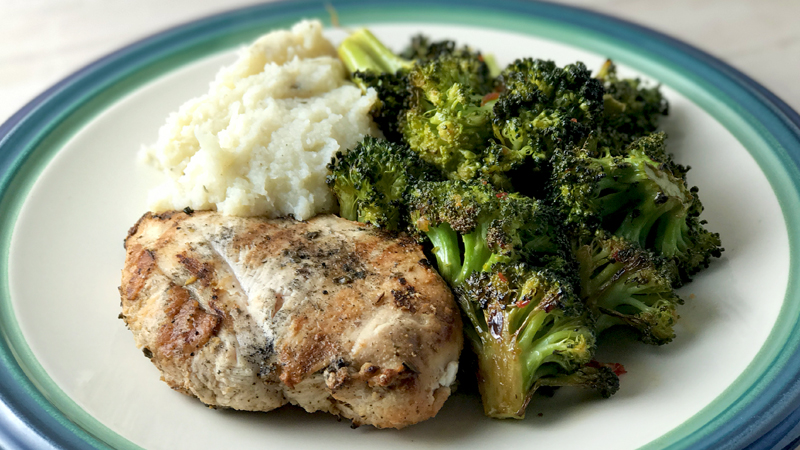
We have completed the first five days of The Whole30 Program based on the book The Whole30: The 30-Day Guide to Total Health and Food Freedom and we’re doing okay. Better than okay actually. Dealing with only eating Whole30 compliant foods isn’t as hard as I thought it would be or as frustrating, boring, and challenging as it seemed from the feedback I received from friends who have completed the The Whole30 Program. I’m thinking this is because we had already cut out soda years ago, try to eat mostly vegetarian at home, and already eat no red meat, no pork, and no dairy. (Although I really wish I could make some steak or a lettuce wrapped burger. But it’s not happening. Once you’ve dealt with cancer like Brian did, red meat is gone forever.)
During the first few days, while Brian felt fine, I did have a little bit of a headache. According to Whole30, this is a symptom of sugar/grain withdrawals, which totally makes sense because I eat way more snacks, chips, and breads than Brian does.
What surprised me was that I wasn’t missing the sugar and bread and chips. It would have been nice to crunch on some chips with lunch, but I didn’t feel like I needed them. We both were also surprised that we weren’t snacking and it didn’t matter. We usually snack. But neither of us felt hungry enough to snack. Maybe it’s because our options were carrots, apples, nuts, celery, or apple chips.
Getting Used To The Whole30 Rules
In my first post about Getting Started With Whole30, I shared the basic rules of The Whole30 Program:
- Do not consume added sugar, real or artificial. No maple syrup, honey, agave nectar, coconut sugar, date syrup, stevia, Splenda, Equal, Nutrasweet, xylitol, etc. Read your labels, because companies sneak sugar into products in ways you might not recognize.
- Do not consume alcohol, in any form, not even for cooking. And ideally, no tobacco products of any sort, either.
- Do not eat grains. This includes (but is not limited to) wheat, rye, barley, oats, corn, rice, millet, bulgur, sorghum, sprouted grains, and all gluten-free pseudo-cereals like quinoa, amaranth, and buckwheat. This also includes all the ways we add wheat, corn, and rice into our foods in the form of bran, germ, starch, and so on. Again, read your labels.
- Do not eat legumes. This includes beans of all kinds (black, red, pinto, navy, white, kidney, lima, fava, etc.), peas, chickpeas, lentils, and peanuts. No peanut butter, either. This also includes all forms of soy — soy sauce, miso, tofu, tempeh, edamame, and all the ways we sneak soy into foods (like lecithin).
- Do not eat dairy. This includes cow, goat, or sheep’s milk products like milk, cream, cheese, kefir, yogurt, sour cream, ice cream, or frozen yogurt.
- Do not consume carrageenan, MSG, or sulfites. If these ingredients appear in any form on the label of your processed food or beverage, it’s out for the Whole30.
- Do not step on the scale or take any body measurements for 30 days. The Whole30 is about so much more than weight loss, and to focus only on body composition means you’ll overlook all of the other dramatic, lifelong benefits this plan has to offer. So, no weighing yourself, analyzing body fat, or taking comparative measurements during your Whole30. (We do encourage you to weigh yourself before and after, so you can see one of the more tangible results of your efforts when your program is over.)
But while we have the rules and the list of Whole30 approved foods, a grocery shopping list, and the common additives cheat sheet, we’re still doing a lot of questioning and wondering, “Is this okay for Whole30?” There are exceptions to the rules and allowed foods and there are foods that aren’t Whole30 compliant off the shelf, but can be made at home in a way that makes them okay to eat during Whole30. It’s confusing at first, but it gets easier each day. Basically, eat as low on the food chain as possible and don’t eat anything processed.
Exceptions to the Whole30 Rules
These foods are exceptions to the rules, and are allowed during Whole30.
- Ghee or clarified butter. These are the only source of dairy allowed during your Whole30. Plain old butter is NOT allowed, as the milk proteins found in non-clarified butter could impact the results of your program.
- Fruit juice. Some products or recipes will include fruit juice as a stand-alone ingredient or natural sweetener, which is fine for the purposes of the Whole30. (We have to draw the line somewhere.)
- Certain legumes. Green beans, sugar snap peas, and snow peas are allowed. While they’re technically a legume, these are far more “pod” than “bean,” and green plant matter is generally good for you.
- Vinegar. Nearly all forms of vinegar, including white, red wine, balsamic, apple cider, and rice, are allowed during your Whole30 program. (The only exception is malt vinegar, which generally contains gluten.)
- Coconut aminos. All brands of coconut aminos (a brewed and naturally fermented soy sauce substitute) are acceptable, even if you see the word “coconut nectar” in the ingredient list.
- Salt. Did you know that all iodized table salt contains sugar? Sugar (often in the form of dextrose) is chemically essential to keep the potassium iodide from oxidizing and being lost. Because all restaurants and pre-packaged foods contain salt, we’re making salt an exception to our “no added sugar” rule.
Also, seed oils — corn oil, rice bran oil, soybean oil, and peanut oil — are off-limits. Others like safflower, sunflower, canola, grapeseed, or sesame oil are allowed at home, but recommended that you keep them to a minimum. That means don’t use canola as your primary cooking fat in your own kitchen.
Another rule that’s not a strict rule is about smoothies. We LOVE smoothies. We replace one meal every day in the warm months with smoothies. But then I was reading through The Whole30 and it said no smoothies. What?! Crap. But then I kept reading and it’s not as much as a rule as it is a recommendation.
There is no official Whole30 ban on smoothies. It is recommended however, that you eat a meal you have to chew instead of drink so you feel more satisfied. Their recommendation is also based on smoothies being mostly fruit, which leads to consuming more sugar, and low in protein. But here’s the deal, if a smoothie has spinach, carrots, tomato, broccoli, and almonds in it, along with the fruit, that’s not the same thing as having a fruit smoothie. They also say that drinking a “huge whackload” of fruit first thing in the morning can set you up for more volatile energy, hunger, and cravings throughout your day — but we usually replace lunch with a smoothie, so I’m not too worried about this rule.
No Sex With Your Pants On
There’s also one other rule that’s really important. No recreating baked goods, junk foods, or treats with healthy ingredients. The authors of The Whole30 call it having sex with your pants on:
Consuming baked goods, junk foods, or treats with “approved” ingredients is just like having sex with your pants on. It’s good… but it’s not that good. You can tell yourself it’s okay, it’s still pretty good, you’re totally satisfied… but that’s kind of a lie. Because you know exactly how good pants-less sex feels.
And if you continue your Whole30 program eating Paleo pizza, Paleo ice cream and Paleo pancakes, well… all it makes you think about is how less-than-stellar this version is, and how delicious the other version would be. Just like… well, you know.
The problem is, if you continue to have sex with your pants on, it’s inevitable that at some point you’re gonna want to take your pants off. And during your Whole30, that spells trouble.
So basically recreating or buying sweets, treats, and trigger foods is totally missing the point of the Whole30 — and a waffle is still a waffle, even if it’s made with coconut flour. That means no Cauliflower Pizza Crust, no paleo baked treats, no making homemade potato chips or french fries because potatoes and sweet potatoes are approved foods.
This is where things get a little sticky for me. I use my waffle iron a lot and the result is that I get foods that look like waffles. But often I’m not using the waffle iron because I want waffles or a treat, I’m using it as a kitchen appliance to cook foods faster than they would normally cook in the oven or to avoid using the oven completely. So this is a major grey area for me and I’m not sure how I’m going to handle it. I think using it purely as an appliance to cook things faster is completely different than using it to make breakfast waffles with almond flour and approved ingredients and pretending it’s Whole30. Hmmmmm…
The Food: Eating Whole30
It’s a good thing that I got used to cooking and baking things for my kids that I can’t eat before starting my first Whole30. If I hadn’t, making them pancakes, muffins, and coffee cake in the mornings would be a lot tougher because the smells fill the whole house! But seeing as they all have dairy, I’m used to watching them enjoy it and am just happy they’re happy.
Whole30 Day 2
Our day started out with coffee cake for the kids and a delicious Mediterranean Artichoke Breakfast Scramble for Brian and I. For lunch, I had two Fuji apples with almond butter, which just may be my easy go to quick meal!
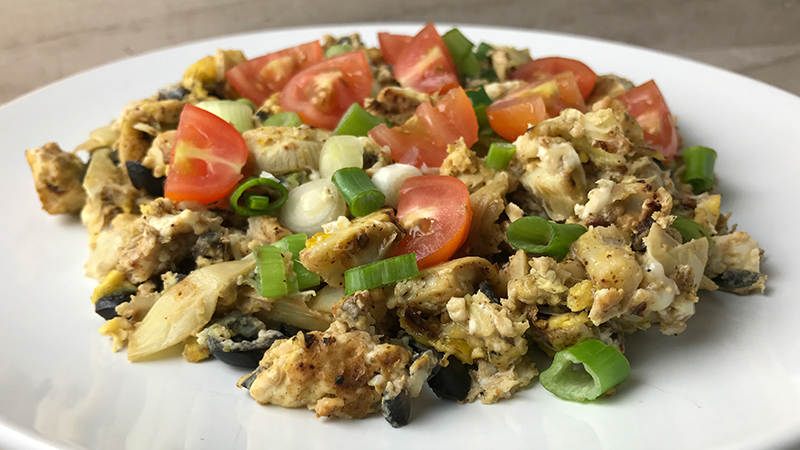
Then for dinner, we had leftover Sweet Italian Marinated Barbecue Chicken and Garlic And Thyme Cauliflower Mash and Chili Garlic Roasted Broccoli. After dinner, I attempted to make homemade Whole30 compliant mayo, but it was a runny, gross, massive failure. It didn’t thicken and I was so mad that all of that olive oil was wasted.

Whole30 Day 3
Brian and I both noticed that without beans and tortillas, our morning breakfast scrambles weren’t keeping us as full as our breakfast burritos did. So I added some red potatoes and avocado to get a little more starch and fat. I made a Red Potato And Veggie Breakfast Scramble, which was super tasty!
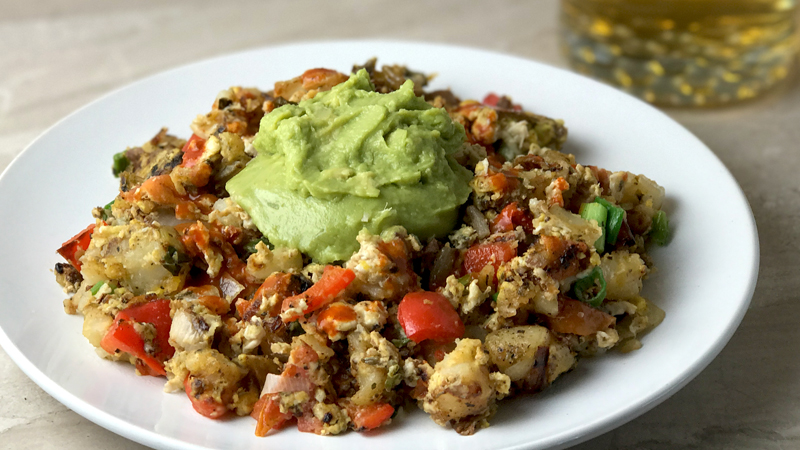
After breakfast, I attempted making homemade Whole30 compliant mayo again and it was a success! It thickened up perfectly. Hooray! I used the lemony mayo to make a delicious Crunchy Dill Chicken Salad with toasted almonds, grapes, and celery. We then made Chicken Salad Lettuce Wraps for lunch with a side of fresh fruit.

We ate lunch late in the day, and ate a really big lunch, so for dinner, I just had apples and almond butter again. Lazy, but easy and fast.
Whole30 Day 4
I started the day with another veggie breakfast scramble, this time a Purple Potato Vegetable Scramble seasoned with garlic powder, onion powder, paprika, and cumin. I also added our morning favorites, onions, tomatoes, bell peppers, and avocado.
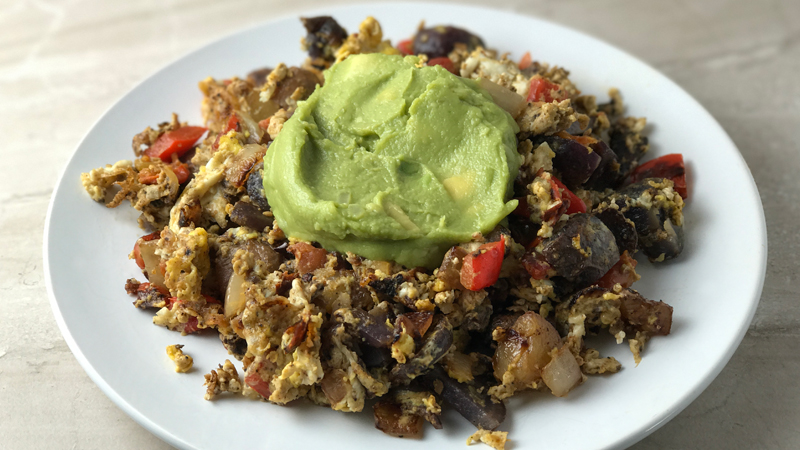
For lunch, we had Crunchy Dill Chicken Salad Lettuce Wraps with a side of fresh fruit again. Then, Brian and I totally lost track of time and failed to leave enough wiggle room in our schedule to eat dinner before the Sacramento WordPress Meetup, which we co-organize, so we just grabbed two waters, two packs of almonds, and two Larabars (one for each of us) to eat in the car on the way there.
Whole30 Day 5
I had a couple of really big client deadlines and was leading a live webinar for the iThemes Training community, and I knew I was going to be quitting early because we watch my nephews on Wednesday afternoons for a few hours. Needless to say, I got to my desk in the morning and powered through until lunch, just grabbing some unsweetened iced tea, some raw almonds, and a few baby carrots to snack on.
For lunch, we had lettuce wraps and fruit salad again, mixing a few chopped, hard boiled eggs into the leftover Crunchy Dill Chicken Salad and added a little more salt, pepper, and dill for taste. Our Dill Egg And Chicken Salad Lettuce Wraps were just as delicious!
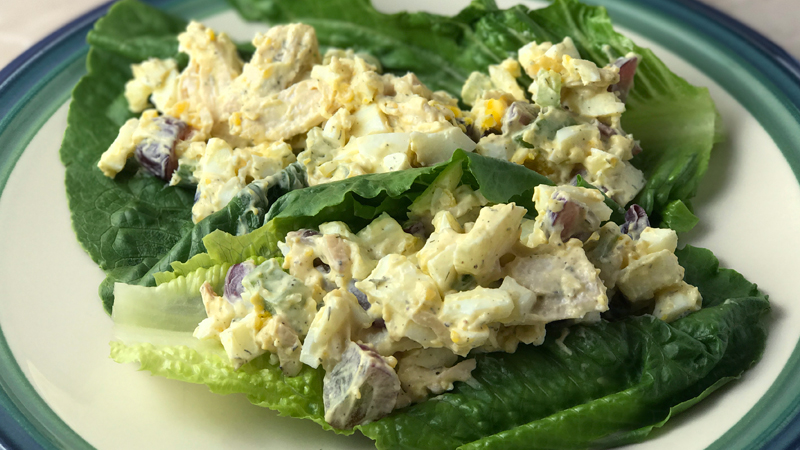
Dinner was apples and almond butter again. Wednesdays are our scrounge nights, where everyone finds something to eat on their own because we juggle babysitting my nephews with homework, Brian’s guitar lesson, Carter’s Karate class, and Natalie’s dance class. My mission for the future of my Whole30 experience is to stop relying on apples and almond butter as much for an easy, lazy cop out.
I really need to make sure that I have some other simple options available.
What I learned About Cooking During Whole 30
When I do meal prep, I do meal prep in bulk. So when we barbecued chicken, we made enough for two meals. When we boiled and shredded chicken for chicken salad, it was enough for two and a half lunches. When we boiled eggs, we boiled a dozen. In theory this sounds great and normally it is. Normally it’s awesome. But normally, I have more other foods and snacks and desserts mixed in so I don’t notice that we’re eating the same foods multiple times in a row. But with Whole30 and no snacking, I really notice the repetitive eating.
I’m only going to buy and prep foods for about 5 days. I can go five days eating similar things cooked different ways or combined with other ingredients in different ways no problem. After that, I start craving something different. This approach will help me keep our grocery costs down by planning meals in a five day period that all use similar ingredients, and let me get all new foods every five days or so.
It’s also been really eye opening just how many things you think are “healthy” have added sugar! It’s insane. By really getting down to the basics, eating low on the food chain, and cutting out all the processed junk, we’re really tasting the food we’re eating. It’s sort of like what happened when I had to cut out dairy and stopped covering things in cheese or ranch. The rich textures and flavors of the natural foods began to shine through and I ended up liking the food I was eating even more.
Oh, and while I don’t mind making my own homemade mayo, there is no way we’re going to get through Whole30 making everything from scratch! So I also bought basically every single item that’s Whole30 approved from Tessemae’s All Natural and I’m anxiously waiting for it all to arrive. I’m also starting to make a food plan for our Whole30 spring break road trip. We’re heading to the Mendocino/Fort Bragg area and packing a big ice chest and portable barbecue with us. This is the first vacation we’re taking while doing Whole30 and I’m a little apprehensive about it.
Follow Along With Our Whole30 Experience
Check out my other Whole30 review posts documenting our daily experiences, including what we eat and cook, and what we struggle with, and awesome Whole30 foods we have discovered:
- Getting Started With Whole30 In The Real World: Day 1
- Getting Used To The Whole30 Rules: Day 2-5
- Whole30 (Spring Break) Road Trip Food: Day 6-10
- Staying On Track With Whole30 On A Holiday: Day 11-16
- Whole30 While You’re Sick, Parties, And Date Night at A Brewery: Day 17-22
- Date Nights And Eating Out During Whole30: Day 23-28